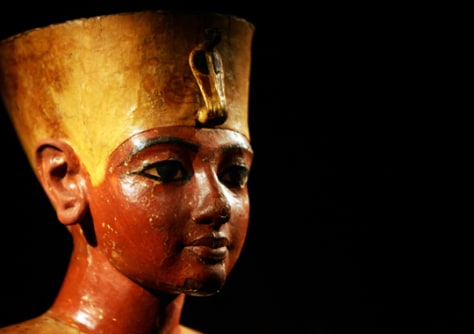As we explore the various aspects
of King Tut’s mummification, and ultimate deification, it is important to
situate him historically. Though some of the theories surrounding Tut are
precarious, some evidence can be drawn from the recorded evidence in his tomb,
and the tombs of other’s. King Tut, or “the boy king” took the throne in 1333
BC at age nine (Reeves, 24 ). Following the rule of Tut’s father, Amenophis IV,
Egypt was in a place of religious and cultural turmoil.
Amenophis IV reigned for 17
years. His time in the throne is most notable for his devotion to the Aten, a
sun disk (Reeves, 18). The basic tenant
of the Aten was written in the Great Hymn to the Aten. Essentially, Amenophis
IV had set in motion a monotheistic belief system, stating, “there is but one
god, the Aten, the sole creator and gentle benefactor of mankind” (Reeves, 18).
Amenophis IV had become the representative for Aten, and in doing so became a
sort of dictator, even changing his name to Akhentaten,
(he-who-is-beneficial-to-the-Aten) (Reeves 18). Amenophis IV made it his life’s work to erase
all signs of the previous polytheistic worship of Amun (Reeves 18).
The decision to enforce
monotheism marked a turn for the worst in Amenophis’s reign. The economic state
of the Egyptian state was destabilized, and much of the duties pertaining to
the everyday running of the country was left to Akhentaten’s men (Reeves, 18).
This led to mass exploitation and feelings of anger from the population (Reeves,
18).
Akhentaten died after 17 years at
the throne, leaving the nation in chaos caused by his overall neglect. What
went on after this are a bit difficult to follow. Akhentaten’s wife
Nefertiti seemed to attempt to hold onto
power by pleading with king of Hitties, Suppiluliumas I, I to send her a son to
marry, he did so, but the he was married en route (Reeves, 23). Nevertheless,
this is an indication of the desperation Egypt was experiencing.
 |
| The boy king. |
After a short reign by
Smenkhkare, Tutamkaten came to power. Though he sat in the throne, it is
believed that much of the power rested with others (Reeves, 24). One thing was for certain, however, Egypt had
to purge itself from the previous damaging effects of the worship of Aten. King
tut, and his wife, Ankhesenpaaten made a point of dropping the “aten’s” from
their names, thus signaling the return to Amun.
For much of the reign of King Tut
he was under the control of his advisors, however as he aged he became harder
to manipulate (Reeves, 33). A theory
surrounding his death is that he was murdered by his closest advisor, heir to
the throne, Ay (Reeve, 33). Ay was
elderly and it is speculated his drive to control power may have caused him to
strike Tut in a manner consistent with the damage to his skull (Reeves, 33).
Whatever the case may be, Tut’s reign ended with his death, just 9 short years
after taking the throne.
For those wanting to know more, below is a great documentary on King Tut.
For those wanting to know more, below is a great documentary on King Tut.
Reeves, C. N. The
Complete Tutankhamun : The King, the Tomb, the Royal Treasure. London:
Thames and Hudson, 1990. Print.
N.d. Who's Your
Daddy? King Tut's Father Identified. Web. 28 Mar. 2014.<http://www.nbcnews.com/id/28279258/ns/technology_and_science-science/t/whos-your-daddy-king-tuts-father-identified/#.UzWlTK1dVgs>.
No comments:
Post a Comment